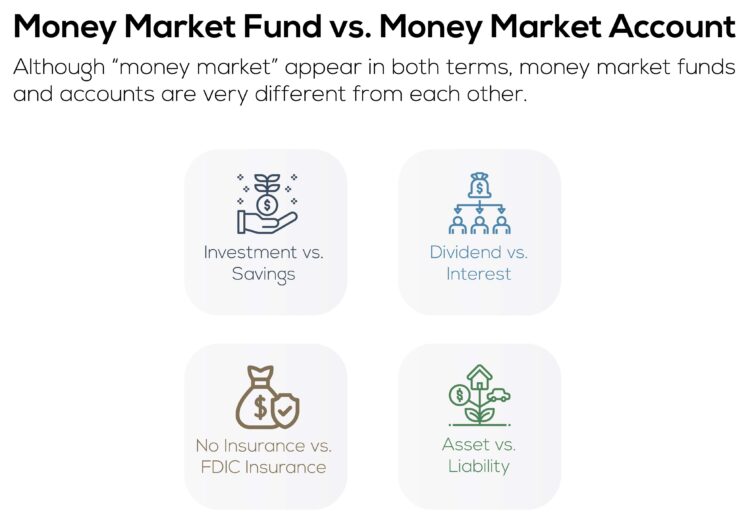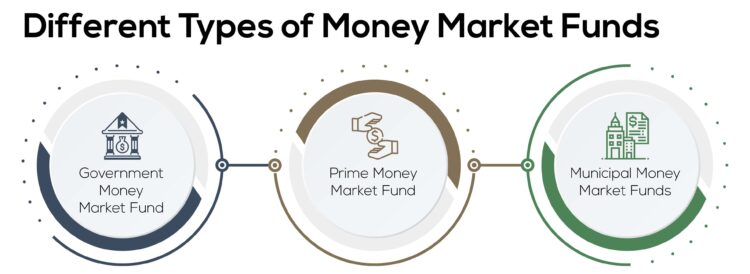What Is a Money Market Fund?
A money market fund is a type of mutual fund that invests in high quality, short-term debt securities. Money market funds are characterized by high liquidity, meaning they can be readily converted into cash. They also have low volatility.
Any earnings received from the fund are distributed to shareholders in the form of a dividend. Depending on the type of securities the fund invests in, the fund may be tax-exempt or taxed.

Although “money market” appears in both terms, money market funds and money market deposit accounts are very different from each other.
Investment vs. Savings
Money market funds are investments offered by an investment company. Money market accounts are savings products offered through a bank or similar savings institution.
Dividend vs. Interest
Only money market funds pay a dividend to their shareholders. Banks pay interest to money market account holders.
No Insurance vs. FDIC Insurance
Like other investments, a money market fund is not covered under by FDIC insurance. If the fund loses money – or the investment company managing it goes bankrupt – investors can lose their money.
A money market account is a bank product and is therefore covered under FDIC insurance for up to $250,000. If the deposit institution files for bankruptcy, account holders can recoup their savings.
Asset vs. Liability
Money market funds are treated as assets held by the brokerage or investment company. Investors are technically buying baskets of securities managed by the money market fund firm.
Money market accounts, on the other hand, are considered liabilities for a bank. The bank can take the money deposited by its account holders and invest it in riskier ventures to make a profit for themselves. Banks pay an agreed-upon interest rate for the use of that money.

There are several types of money market funds, each defined by the type of investments allowed in the fund and the duration of the investments.
Government Money Market Fund
The US government defines government money market funds as “funds that invest 99.5% or more of their total assets in liquid investments (e.g. cash, government securities, repurchase agreements fully collateralized with government securities).”
Such funds include US Treasuries and repurchase agreements collateralized by US Treasury securities. Government money market funds use special pricing and valuations when calculating the share price to keep their net asset value (NAV) at $1 per share. NAV is the per-share value of a fund’s assets minus its liabilities.
Prime Money Market Fund
Prime money market funds invest in floating-rate commercial paper. Floating rate (also called variable rate) refers to an interest rate that rises or falls either with the market rate or an index rate. Prime money market funds invest in variable rate debt and commercial paper of corporations, government-sponsored enterprises, and government agencies.
Municipal Money Market Funds
A municipal money market fund invests in municipal bonds. These funds are typically free from federal, state, and alternative minimum taxes. Like government funds, they also trade at a stable NAV of $1 per share.
Specific Money Market Funds
Many companies offer money market funds. Two of most popular choices include the Vanguard Prime Money Market Fund and Fidelity Money Market Fund.
Vanguard Prime Money Market Fund
The Vanguard Prime Money Market Fund (VMMXX) is a taxable money market fund that invests in highly-liquid securities with short-term securities. This includes US Treasury bills and cash. The fund requires an initial $3,000 investment and has a fixed-price share fund with a NAV of $1 per share.
Fidelity Money Market Fund
The Fidelity Money Market Fund (SPRXX) invests in US dollar-denominated money market securities of domestic and foreign issuers, US government securities, and repurchase agreements. It is a taxable fund. Compared to government funds, prime funds like the Fidelity Money Market Fund perform better over time.
Are Money Market Funds Cash Equivalents?
Money market funds are highly liquid, meaning they can be quickly converted into cash. The SEC states that prime money market funds – or those with a floating interest rate – are cash equivalents. Accordingly, these funds are treated as cash equivalents under Generally Accepted Accounting Practices (GAAP).
How to Withdraw Money Market Funds
Shareholders can withdraw money by selling shares and transferring the proceeds into their bank account. Shareholders sell their shares via an online request through their fund company’s website (or via a phone call to their fund company or broker). The money can then be sent to the shareholder’s savings/checking account via an electronic fund transfer, used to purchase shares in another fund, or mailed as a check to the shareholder.
Are Money Market Fund Withdrawals Taxable?
Money market funds usually pay their proceeds as dividends, not interest. These are normally taxable though some types of municipal money market funds are tax-free.
For specific tax information on money market funds, please see the IRS Publication 550, Investment Income and Expenses.
Are Money Market Funds Good for Emergency Funds?
Money market funds are good emergency funds because there is no limit to the number of withdrawals or the amount of the withdrawal you can make. If you have excess cash that you’d like to keep aside for emergencies, money market funds pay higher dividends than bank checking and savings accounts. They also offer a low-risk place to save.
You should also consider using a money market account for this purpose though, as they offer more stable rates without the risk of loss of principal and the added benefit of FDIC insurance.
Can Money Market Funds Lose Money?
Because these funds have floating or variable rates, they can move up or down, depending on the market or the index. During especially volatile markets, these funds may indeed lose money. Also keep in mind that money market funds carry an expense ratio which is important to consider as this reduces your return or yield in this case relative to a typical saving ount.
Funds with a stable net asset value (NAV = $1 per share) can actually fall below that figure. This is called “breaking the buck.” It’s a very rare occurrence and only three funds in the entire 37-year history of money market funds experienced “breaking the buck.” When it does happen, companies managing the funds may step in and infuse capital (or take other steps) to prevent the SEC from liquidating the fund.
When Did Money Market Funds Begin?
Money market funds were developed during the 1970s to offer investors an alternative to interest-bearing bank accounts. While money market funds offer returns typically higher than bank accounts, they are not insured by the FDIC.
Money Market Oversight
In the United States, the Securities and Exchange Commission (SEC) oversees the activities of money market funds.The SEC describes money market funds as “low risk” and they often appeal to investors with low risk tolerance.
Historical Returns of Money Market Funds
The historic return of money market funds varies according to the year and the fund.
The SEC tracks the historic returns of money market funds by month and year. Each specific money market fund tracks its own data. Here are several major funds and links to their data:
Money Market Funds vs. High-Yield Savings
A high yield savings account is a special type of savings account that pays many times the typical interest rate. High yield savings accounts pay much higher interest than the prevailing interest rate. If the current interest rate is 1%, the high yield account may offer 2%, for example. High-yield savings accounts are also FDIC insured.
That said, choosing between a money market fund and a high-yield savings account depends on the current interest rate. For several years after the 2008 financial crisis, high-yield savings accounts paid more in interest than many investors could make in a money market fund. But when interest rates began falling, high-yield savings accounts paid less and lost their appeal.
Like other savings products, high-yield savings accounts have a limit of 6 withdrawals per month. That limit is set by a Federal Reserve regulation. Money market funds have no withdrawal limits.
How to Choose the Best Money Market Fund for You
Now that you’ve learned all about money market funds, your next question is probably, “How do I choose the best one?”
Compare Multiple Funds
Look for money market funds with lowest risk, lowest expenses, and highest yield. MutualFunds.com offers a table of various funds that makes it easy to compare them, or you can use a calculator (which we’ve linked to below) to estimate returns.
Consider Minimum Thresholds
Another consideration is the minimum investment thresholds. Obviously, if you have $1,000 to invest and the fund requires a $3,000 minimum investment, it’s not an option right now.
Read the Prospectus
Read through the prospectus for any mutual fund (or any investment, for that matter) that you’re considering. The prospectus offers insight into who managed the fund, how it is managed, what expenses it charges, and any fees associated with the account. Make sure you understand what the fund invests in and purchases and that you are comfortable with the instruments it buys.
Remember That the Past Doesn’t Predict the Future
And, always remember that past performance is not an indicator of future performance. Although a track record for a fund is helpful, no one can predict the future, and there are no guarantees that a fund will perform in the future as it has in the past.
Money market funds typically display a 7-day yield, which attempts to show what an annualized return would be based on the rate for the last 7 days. Again, this is constantly changing so is not guaranteed like a CD nor as stable as a typical high-yield savings account.
Money Market Fund Calculator
A money market fund calculator enables investors to calculate the compound interest on your account. You can also use a savings calculator for similar insights.
It’s a good idea to run the numbers on various money market funds to view the potential interest on the account and compare funds. The information on fund fees, initial investment, and potential return is included in each fund’s prospectus, a legal disclosure document fund companies must provide to potential investors.




